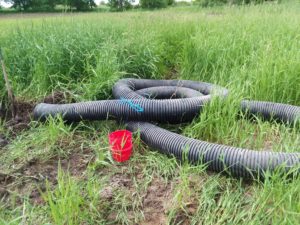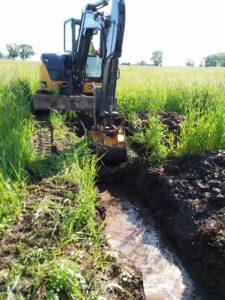Eric Cooley, Discovery Farms Co-Director
Many farmers have purchased or are considering purchasing equipment to modify existing drainage tile systems or install new ones. Owning your own equipment allows you to install or repair systems as time and money allows. Although the ability to “do it yourself” is great, there are many things that should be considered before starting.
The old adage, “Do it right the first time or don’t do it at all,” couldn’t hold truer with tile drainage systems. A properly designed and installed tile system will provide many crop production benefits and should outlast anyone reading this article. If not installed correctly, it can be a source of constant problems and may negatively impact other tiled fields. State and federal rule compliance, adequate site assessment for tile needs and outlets, proper engineering design and correct installation are critical to get the biggest bang for the buck from your tile system.
Rule compliance: There are multiple state and federal codes in conjunction with established drainage district rules that mandate tile system installation and modification. Accidental or unintentional violations of these rules can result in substantial fines and even loss of Farm Bill benefits (including crop insurance premium subsidies, FSA loans and NRCS programs). It is important to consult with a tile drainage professional or local agency personnel to ensure compliance.
Site assessment: Many considerations need to be identified and determined even prior to designing or modifying an existing tile system. They include, but are not limited to:
- soil types
- restricting soil layers
- bedrock depth
- outlet point(s)
- closed depressions
- wetland boundaries (can differ between regulatory organizations)
- locations of any existing tile systems.
Inadequate site assessment can result in poor engineering design and installation challenges. In addition, it is important to plan for any future tile system expansion or connecting of upland tile systems so tile mains/submains can be properly sized to accommodate future flow volumes. It is far more economical increase the initial size of the main by a few inches now instead of installing a secondary main a few years down the road.
Engineering design: Proper engineering design is vital for proper tile system operation and function and should be done by qualified personnel. Determining the acres to be drained and the drainage coefficient (inches/24 hours) are first steps in tile system design, but many other factors also need to be considered including:
- installation grade
- single vs dual wall
- mineral vs organic soils
- tile spacing
- surfaces inlets (open vs blind)
- pipe size
- length of run
- adequate venting
- subject to fine sand or silt
- sock vs no-sock
- other factors influencing tile system operation and performance.
There are many new and emerging technologies to enhance tile system functionality such as water level control structures, saturated buffers, constructed wetlands, bioreactors, two-stage drainage ditches and others which are more economical to add initially than after the tile system is already installed. Most of these practices have cost-sharing available so talk to your local NRCS representative or tile installation professional for more information.
Proper installation: Although the economics of owning your own tile installation equipment has become more viable than in the past, professional tile installers have equipment that often reduces soil disturbance and compaction, provides more consistent slope of pipe, better support and contact of soil with tile pipe to enhance initial system function, deeper burial depth capacity to cross any high spots in the field, and can create georeferenced maps during the installation process.
If you are installing your own tile, at a minimum you should be using a GPS to mark the location and annotate the size of each tile as you install it to create an as-installed map. GPS technology is very inexpensive and will provide you ease of accurately finding the tile in the future for any needed repairs or spill response. Finally, ensure you properly mark and protect all tile outlets, vents and open tile inlets to prevent accidental damage.
Tile drainage systems can enhance agricultural crop production, especially in poorly drained landscapes, but only when tile systems are properly designed, installed and maintained. Although tile installation equipment is becoming more economical for the do-it-yourself farmer, there are many considerations to properly site, design and install tile drainage systems.
If you are new to the tile installation process, contact a local tile installation professional or tile supplier to aid in the process. A good rule of thumb is, when in doubt, hire or consult a tile drainage professional. Consulting fees charged by professionals to aid you in the process are much cheaper than fixing simple errors later. As a reminder, agricultural tile drainage systems are not a “set it and forget it” system, annual inspections and maintenance should be done to ensure proper operation and longevity of your tile system to protect your investment.



